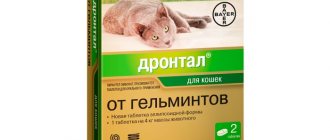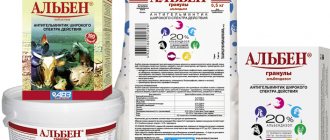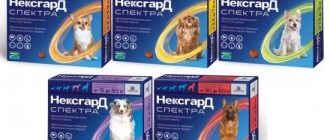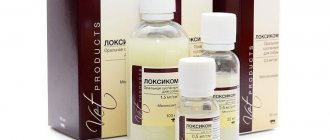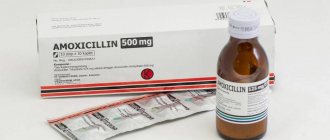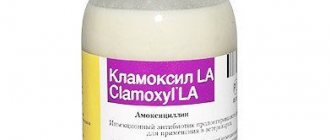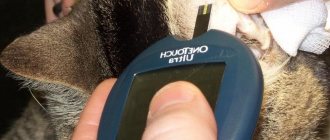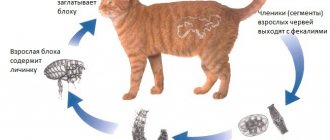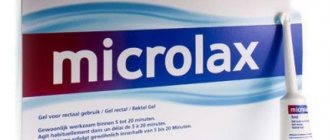Dirofen Suspension 20 for kittens and puppies, instructions
General information
1. Name of the medicinal product for veterinary use: trade name: Dirofen-suspension 20 and 60;
international nonproprietary name of the active ingredients: pyrantel and praziquantel. 2. Dosage form: suspension for oral administration. The drug is produced in two dosages: Dirofen-suspension 20 (for kittens, puppies, ferrets and decorative rodents) and Dirofen-suspension 60 (for adult dogs and cats), containing in 1 ml as active ingredients, respectively: pyrantel pamoate - 15 mg and 45 mg and praziquantel - 5 mg and 15 mg, as well as excipients: pumpkin seed oil, polysorbate-80, Na-carboxymethylcellulose, aspasvit C 200, sodium benzoate, potassium sorbate, glycerin, 20% polydimethylsiloxane emulsion, xanthan gum, purified water .
3. In appearance, the drug is a suspension from light yellow to dark yellow in color with particles uniformly distributed in it. During storage, separation of the suspension is allowed,
disappearing after shaking.
The shelf life of the medicinal product, subject to storage conditions in the manufacturer's closed packaging, is 2 years from the date of production, after opening the bottle - 90 days.
The use of Dirofen suspension 20 and 60 after the expiration date is prohibited.
4. The drug is released packaged in 5, 6, 7, 10, 15, 30 ml bottles made of polymer materials, sealed with screw caps and packaged individually in cardboard packs complete with instructions
instructions for use, a dispenser syringe and stickers in the veterinary passport.
5. Store the drug in the manufacturer’s sealed packaging, in a place protected from direct sunlight, separately from food and feed at a temperature of 0 °C to 25 °C.
6. Dirofen suspension 20 and 60 should be stored out of the reach of children.
7. Unused drug is disposed of in accordance with legal requirements.
8. Dispensing conditions: without a veterinarian's prescription.
Pharmacological properties
9. Dirofen suspension 20 and 60 belongs to the group of anthelmintic drugs in combination.
10. The combination of praziquantel and pyrantel pamoate included in the drug has a wide spectrum of anthelmintic effect on all phases of development of round and tapeworms parasitizing dogs, cats, ferrets (Toxocara canis, Toxosara mystax, Toxascaris leonina, Taenia solium, Uncinaria stenocephala, Ancylostoma caninum , Echinococcus granulosus, Alveococсus multilocularis, Mesocestoides lineatus, Dipylidium caninum, Diphyllobothrium latum, Multiceps multiceps) and in ornamental rodents (Syphacia obvelata, Syphacia muris, Aspiculuris tetraptera, Rodentolepis straminea, Hymenolepis nana, Hymenolepis diminuta).
Pyrantel pamoate is a compound of the pyrimidine group, active against sexually mature and immature nematodes, its mechanism of action is based on blocking the transmission of nerve impulses at neuromuscular synapses by depolarizing the membranes of muscle cells, which causes paralysis of the muscular system of nematodes; pyrantel is poorly absorbed, which ensures its prolonged effect on helminths in the intestines; excreted from the body mainly unchanged (93%) in feces.
Praziquantel is a compound of the pyrazinisoquinoline group, active against mature and immature cestodes; its mechanism of action is based on inducing the disintegration of the tegument and inhibition of fumarate reductase, persistent depolarization of helminth muscle cells, disruption of energy metabolism, which causes paralysis and death of cestodes and promotes their removal from the gastrointestinal tract. Praziquantel is quickly absorbed in the gastrointestinal tract, reaching maximum concentration in the blood plasma after 1 - 3 hours, distributed in the organs and tissues of the animal; binds to serum proteins (70 - 80%), is partially metabolized in the liver, re-excreted into the intestines, and excreted from the body mainly in the urine (up to 80%).
Dirofen-suspension 20 and Dirofen-suspension 60 in terms of the degree of impact on the body are classified as low-hazard substances (hazard class 4 according to GOST 12.1.007-76), in recommended doses they do not have embryotoxic,
teratogenic and sensitizing effects. Well tolerated by dogs and cats of different breeds and ages, ferrets and decorative rodents.
Dosage form and composition
Dirofen is produced in three dosage forms:
- pills;
- suspension;
- paste.
Suspension and paste for oral administration have almost identical composition. The active ingredients are praziquantel and pyrantel pamoate. Dirofen 20 suspension and paste are available for adult cats and kittens. The main difference between them is in the auxiliary components and appearance. The suspension is a viscous liquid of light yellow color, which is packaged in polymer bottles of 6 or 7 ml. The paste has a paste-like consistency and is packaged in polymer syringe dispensers, which is very convenient for use. There are different packaging - 6 and 7 ml.
The composition of the active components of the tablets is supplemented with febantel. They also contain auxiliary substances:
- talc;
- microcrystalline cellulose;
- calcium stearate;
- lactose;
- colloidal silicon dioxide.
Round, light yellow tablets have two dividing grooves located at right angles to each other. They allow you to divide the tablet into 4 equal parts. Thanks to this, you can accurately measure the required amount of anthelmintic even for small pets. Tablets are packed in 6 pieces. There are two types:
- 120 mg are intended for kittens;
- 200 mg each are developed for adult cats.
The main difference between them is the concentration of active substances.
Note! The drug is available in several versions for cats and dogs. When purchasing, select Dirofen intended for cats or kittens, and carefully study the instructions for use to avoid overdose.
Storage conditions and cost
It is important to store Dirofen in any form in a place where moisture and sunlight do not penetrate, and inaccessible to pets and children. Do not place the medicine near food and feed. At temperatures from -10 to +20 ºС, the drug is stored for 3 years.
The medicine is not toxic, and if consumed by a person, it is enough to rinse the body with copious amounts of water. After using the product, you should wash your hands with regular soap under running water.
The cost of medications is affected by the form of release, dosage and markup of the veterinary pharmacy:
- a dosage of 120 mg tablets costs about 125 rubles;
- Dirofen tablets 200 mg approximately 140 rubles;
- the product in the form of a paste will cost around 165 rubles;
- the suspension can be purchased at a price of around 180 rubles.
Dirofen for pets is an effective drug for combating different types of worms. The main thing is to adhere to the dosage specified in the instructions for use. This is a kind of poison for helminths, an overdose of which can harm the cat.
Feedback from cat owners
I liked Dirofen Plus in terms of dosage. The kitten suffered from constipation until he was dewormed - exactly one tablet for the little sufferer solved all his troubles. And at one time. Vika, 26 years old
We worm the cat every quarter. We use Dirofen Plus. She weighs 6 kg. We use two tablets at once - one from the package for kittens, the second - for adult cats. Katya, 24 years old
Courtyard cats are medium in size. We periodically save them from parasites. Dirofen plus tablets are eaten by themselves, with pleasure. We never noticed any side effects. Convenient and not expensive. Nadezhda, 30 years old
Cost and analogues of Dirofen
The medicine is inexpensive. Its cost, depending on the dosage, ranges from 100 to 150 rubles.
Dirofen is an inexpensive drug
If the use of the drug is contraindicated for some reason, then its analogues are prescribed.
The main ones are:
- Prazicide;
- Drontal;
- Pyrantel;
- Febantel;
- Praziquantel;
- Profender.
Before using the analogue, it is recommended to consult a veterinarian.
Compatibility with other drugs
According to the manufacturer's existing recommendations, the drug should not be used in combination with Piperazine and other medications that help slow down the synthesis of cholinesterase enzymes in the body.
Important! To achieve the desired effect, it is necessary to avoid violating the above-described regimen for using Dirofen Plus. If you are unable to comply with the required time between doses, you need to administer the product as soon as possible, but the interval between subsequent applications should not be changed.
Reviews from pet owners
Helminthiasis is a fairly common disease found in animals. It must be treated, otherwise it will lead to painful conditions in the puppies and death.
According to reviews from animal owners, Dirofen is an effective anthelmintic that does not cause adverse reactions. Its use makes it possible to quickly cure diseases such as cestodosis and nematodosis.
Consumers claim that using this medication does not cause any particular difficulties. It is simply mixed with food and given to animals during morning feeding hours.
Indications for use of Dirofen
The anthelmintic Dirofen is indicated for the following types of helminthic infestations:
- toxocariasis and toxascariasis;
- uncinariasis and trichocephalosis;
- hookworm;
- taeniasis and dipylidiasis;
- echinococcosis and diphyllobothriasis;
- mesocestoidosis;
- mixed nematodes-cestodes.
Despite the fact that Dirofen is a complex anthelmintic, it cannot be used just like that. Dirofen can be used for prevention, but it is recommended to do this with caution. The fact is that all anthelmintics are toxic to some extent, and careless use can aggravate the animal’s condition.
Your veterinarian can determine the correct dosage and treatment regimen for your cat.
Instructions for use
For preventive purposes, an anthelmintic is given once every 3 months, as well as 10 days before each vaccination. For helminthic infestations, the drug is given once, and in case of severe infection, the procedure is repeated after 10 days. The dosage of the medicine is calculated taking into account the weight of the animal and the dosage form of the medicine:
- One tablet of 120 mg is designed for 1 kg of animal weight, 200 mg - for 5 kg of weight. Smaller tablets are usually used for kittens and small animals.
- 1 ml of Dirofen 20 suspension is calculated for 1 kg of weight.
- If you use Dirofen 20 paste for cats, then for every 1 kg of weight you will need 1 ml of medication.
The anthelmintic should be given in the morning feeding. The drug can be given forcibly (put a tablet on the root of the tongue, squeeze a suspension or paste from a syringe into the oral cavity) or mixed with a small amount of food (canned food, minced meat, etc.). The tablet can be hidden in a piece of sausage or meat, depending on the pet’s preferences.
Note! There is no need to follow a starvation diet before using the medicine or give the animal laxatives.
It is advisable not to violate the regimen of using an anthelmintic, especially during prophylaxis, since in this case its effectiveness decreases and the risk of infection with parasites increases.
Indications for use of Dirofen
In accordance with the instructions, the drug is prescribed to pets to combat the following parasites:
- cestodoses;
- nematodes;
- mixed helminthic infestations.
Additionally, the medicine is used as a prophylactic to prevent the animal from becoming infected with worms. As a preventative measure, deworming is carried out once every 90 days. At the same time, not only animals that come into contact with street cats are dewormed, but also pets that permanently live in the apartment. The cat owner can bring helminth larvae into the house through dirt on shoes, raw meat products, and other means.
Deworming is mandatory before vaccinations. This is due to the fact that helminths contribute to a sharp decrease in immunity. The products they release during their life processes are toxic to animals. This leads to various complications after vaccination.
Contraindications and side effects
Dirofen tablets, paste and suspension are not used for cats in the following cases:
- in case of intolerance to components;
- when exhausted;
- for infectious diseases;
- during the rehabilitation period after surgery or serious illness.
Do not give anthelmintic to kittens under 3 weeks of age. If your animal has chronic liver and kidney diseases, you should consult a doctor.
For pregnant cats, the drug is not used in the first half of pregnancy. The use of the medicine is possible only under the supervision of a doctor. It is allowed to carry out deworming 3 weeks before the expected birth and 2-3 weeks after the birth of kittens.
When using the drug, especially for the first time, increased salivation may be observed. In rare cases, vomiting or loose stools occur. Symptoms usually go away on their own and do not require special treatment. If an allergy develops, the animal is given an anti-allergenic agent.
Dirofen is considered a safe anthelmintic, but in case of overdose it can cause side effects:
- nausea and vomiting;
- stomach upset;
- lack of appetite;
- depressed state;
- apathy, etc.
